|
During 1892-1945, the Springfield Armory underwent considerable
growth and change requiring creative solutions to new and constantly emerging
problems. Before this period, these dilemmas were primarily technical, but as
time and technology progressed, they became increasingly social.
In previous years, the production capacity of the Springfield Armory was limited
by the availability of highly skilled workers and by the technology of production
- the design and application of machinery - available to assist these craftsmen.
Advances in the technology of production over time de-skilled the process of
firearm manufacturing by diversifying and multiplying the machinery, thus making
the manufacturing process itself less and less about the craftsman and more and
more about the machine.
 Prior innovations and methods pioneered at the Springfield Armory virtually
guaranteed a consistent, precise, high-quality product from every machine regardless
of who operated it. Truly, the training required to run these machines was only
a slim fraction of the training required to build a rifle from scratch by hand.
As a result (the technologyof production having reached somewhat of a pinnacle),
the overall emphasis at the Armory at the beginning of this era marked a distinct
shift away from the technology of production and toward the technology of the
product, as evidenced by the establishment of the first Experimental Department
there in 1891. Prior innovations and methods pioneered at the Springfield Armory virtually
guaranteed a consistent, precise, high-quality product from every machine regardless
of who operated it. Truly, the training required to run these machines was only
a slim fraction of the training required to build a rifle from scratch by hand.
As a result (the technologyof production having reached somewhat of a pinnacle),
the overall emphasis at the Armory at the beginning of this era marked a distinct
shift away from the technology of production and toward the technology of the
product, as evidenced by the establishment of the first Experimental Department
there in 1891.
Now that producing quality was nearly assured, a combination of U.S. foreign
policy and other world events throughout this period required the Springfield
Armory to grapple with the problems of producing quantity. Like the metamorphosis
of the shop floor – from craftsman to machine – warfare itself in
this era shifted from a contest of soldiers to a contest of industry; essentially
a contest of production. This invariably increased the magnitude of warfare to
a scale never before seen. Indeed, just prior to the outbreak of the Spanish
American War in 1898, the entire U.S. Army numbered roughly 28,000. By the end
of World War II, total U.S. armed forces enrollment was above 16.5 million. The
Springfield Armory was a vital cog in the U.S. production machine throughout
the years 1892-1945.
It was this expansion of the scope of warfare that pulled traditional labor
forces (mostly white men) away from the home front to the front lines and simultaneously
created enormous demand for the Armory’s products. It was precisely this
demand that forced the Armory, and industry in general, to tap into new labor
forces, drawing on populations that were never previously considered anywhere
near as capable as the men who were now absent. As such, a profound social statement
from marginalized groups was brought to the forefront of the social discourse
within the entire United States, and that statement was:
This section of the website was made possible through grants from the
National Park Service’s, “Parks as Classroom”
and the National Rifle Association (NRA) which was awarded to the Friends
of the Springfield Armory Museum Inc. |